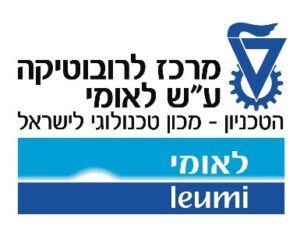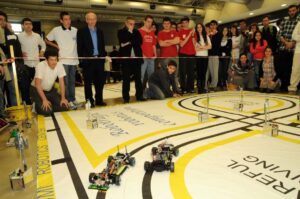
Virtual RoboTraffic Rules
Competition Challenge
The main challenge is to build an autonomous robotic car model that can move according to the traffic rules e.g. traffic lights, signs signals and keep safe distance.
The major goals of this competition are:
Familiarize the students with the traffic laws
- Understand the limitations of the car and driver
- Develop sensors and systems by students that in the long run, will be implemented in real systems in order to reduce the number of car accidents
- Educate the students in the high tech multi-disciplinary area of robots and sensors
- Develop team-working environment.
Participants
1-8 School Students per team.
Competition Categories
- Careful Driving
- Racing
- Reverse Parking
- Traffic safety initiatives
- 3D CAD category.
- 4-wheel Lego car category
- Special automatic control basics test.
Competition Method, Rules and Scoring
A. Careful Driving
The judging in this category will be online through Zoom.
A playground assigned by the committee is used for one robot line tracing according to the traffic lights signals. Performance of the robots is judged by its tracing ability without infringements of traffic regulations and accidents for 2 minutes. When the 2 minutes round is completed without infringements and accidents, every team gets 0 penalty points. Each team has 2 attempts. The team with minimum penalty points is winning. START condition: when the traffic light turns green, the car starts moving.
The team gets penalty points for the following infringements of traffic regulations:
- No stopping before the stop line at a red light – 4 points
- Blocking junction – 4 points
- Leaving the route with 4 wheels or stopping – 1 point
- Clash with another car (any box located at the site) – 5 points
- Starting a game, not by traffic lights – 1 point.
In the case of an equal number of points wins the car with the higher number of cycles. One cycle is a “figure eight”, as well as a part of the cycle.
IMPORTANT!
In case of insufficient number of traffic lights, it is allowed to move them from position to position manually
Traffic light codes for programming: Red – 0; Red with Yellow – 1; Green – 2; Green flashing – 3; Yellow – 4. Traffic light timing: Red – 7 sec; Red with Yellow – 3 sec; Green – 10 sec; Green flashing – 2 sec; Yellow – 3 sec.
The black boxes dimensions: 40cm*20cm*15cm.
Please modify the arena according to the attached layout!
Careful driving layout Careful driving arena (ready for printing).
B. Racing
The judging in this category will be online through Zoom.
One robotic car must move quickly from start to finish. The fastest car is the winner. Each team has 2 attempts.
START condition: Car racing starts after green light of the traffic light.
The black boxes dimensions: 40cm*20cm*15cm.
Please modify the arena according to the attached layout!
Racing layout Racing arena (ready for printing).
C. Reverse Parking
The judging in this category will be online through Zoom.
One robotic car should move from the start (parking lot -1) when the traffic light turns green and continues its moving towards the box installed on the track. After that, the car stops in front of the box for 5-7 seconds, and then moves in reverse to a stop in the parking lot -2, without touching the boundary lines (see red arrows). Further, after 5-7 seconds stopping in the lot -2, the car moves back towards the box (see green arrows) and stops in front of the box for 5-7 seconds. After this, the car moves in reverse to a stop in the parking lot -1, without touching the boundary lines (see blue arrows).
Each team has 2 attempts. The team with minimum penalty points is winning.
START condition: when the traffic light turns green, the car starts moving.
The team gets penalty points for the following infringements of the rules:
- No stopping before the box – 5 points
- Stopping before the box and in parking lots less than 5 seconds – 5 points
- Leaving the route with 4 wheels or cessation of movement – 5 points
- Touching the boundary lines in the parking lots – 5 points
- Starting a game, not by green signal of traffic light – 5 points.
In the case of an equal number of points wins the faster car.
The robotic car should move according to the attached layout.
The black boxes dimensions: 40cm*20cm*15cm.
Please modify the careful driving arena according to the attached layout!
Reverse Parking layout Careful driving arena (ready for printing).
D. Traffic safety initiatives
This competition includes 7 minutes PowerPoint Oral Presentation.
A team should prepare a presentation and make video with the explanations. The presentation and video should be submitted to the Technion by March 1, 2024 preferably through Google Drive.
The team that expresses good knowledge and suggests best new idea to improve real and autonomous cars safety is the winner.
Judging will be according to the following criteria:
- The idea is the most original
- The idea is the most applicable
- The software algorithm is the most effective
- The presentation is the most convincing.
E. 3D CAD category
This competition designed to learn a car construction. The team that expresses good knowledge and presents the high-quality 3D CAD file for a given assignment is the winner.
A team should prepare a presentation and make video with the explanations. The presentation, video, and 3D CAD files (preferably in SOLIDWORKS) should be submitted to the Technion (preferably through Google Drive) by March 1, 2024.
3D CAD files must be visible in SOLIDWORKS.
In addition, the participants will be asked questions through ZOOM.
Judging will be according to the following criteria:
- a) 3D CAD file quality and complexity.
- b) Oral explanations convincing.
2024 Assignment: draw a Continuously variable transmission (CVT) and explain how the transmission works and for what purpose it is used.
F. 4-wheel Lego car category
A car should be equipped with an Ackerman mechanism for the front wheels and a Differential (system of gears) for the rear wheels.
Please see other rules in A. Careful Driving category.
G. Special automatic control basics test
This test is individual.
20 questions must be answered with no mistake.
The main subjects: microcontroller programming; proportional-integral-derivative (PID) controller; pulse width modulation (PWM), and H-bridge electronic circuit.
The test will be given after the performance of each team for additional 40 minutes through Zoom breakout rooms chat.
Playground dimensions and robotic car requirements
The playground represents a realistic highway model with intersections. It equipped with traffic lights and obstacles. The overall arena dimensions are 450 x 450 cm. The black line width is 50 mm.
Car lengths: no more than 425mm. Car width: no more than 210mm. Teams can use any electronic hardware to assemble the car model. A car model has to be equipped with the Ackermann steering geometry.

Leumi Robotics Center, Faculty of Mechanical Engineering, Technion City, IL-3200 Haifa
evgenyk@technion.ac.il Phone: 972-4-829-5490
